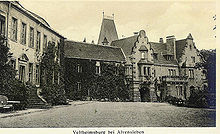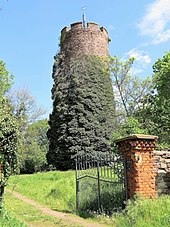Veltheimsburg
The former castle Alvensleben, today: Veltheimsburg , is a former castle complex in the district of Bebertal , which belongs to today's municipality of Hohe Börde and was created in 1950 from the merger of the municipalities of Alvensleben and Dönstedt.
| Veltheimsburg | ||
|---|---|---|
| Alternative name (s): | Veltheimsburg | |
| Creation time : | Bischofsburg: first mentioned 1180 Margrave castle: before 1245 |
|
| Castle type : | Spurburg | |
| Conservation status: | preserved keep, rebuilt | |
| Standing position : | Bishop's Castle or Margrave Castle | |
| Place: | Bebertal | |
| Geographical location | 52 ° 14 '22 " N , 11 ° 19' 50" E | |
|
|
||
Early history and names
The archdeaconate Alvensleben was one of the oldest branches of the Halberstadt Monastery . To protect it, the bishops founded a castle on a rock above the Bever valley, in whose care a market town was built in the 10th century (first, although unsecured, documentary mention in 964). Nineteen parishes belonged to the administrative district of the castle. The episcopal ministerial family von Alvensleben named themselves after the place, and it is documented that they held the office of bailiffs for the first time in 1175 and until the 13th century.
The name Alvensleben is derived from a not exactly known personal name of a family of names that starts with the syllable Alf-, Alv-, Alb-, Alp- u. Ä. Begins and is mostly associated with the albums or elves, z. B. Albwin (Old High German: "alp" = elf, nature spirit, "wini" = friend, i.e. elf friend), Alberich (who is powerful through albums) or Alf (abbreviated form of Alfert = splendid albums) as well as from the ending -leben (= legacy , Inheritance). The meaning of the place name is thus to be understood as "property or heir of Albwin, Alberich or Alf". It can probably be dated to the pre-Carolingian period. The old tradition that the name can be traced back to Alvo is considered unlikely.
In the Middle Ages, the market and the village of Alvensleben - enclosed by walls and gates - were a structure that was rigid with towers. The wall ring of the place enclosed two churches and six tower courtyards of the knighthood. Silver mining was carried out in the area.
The adjacent map shows the site plan of the castle hill according to the separation map from 1833/35.
The place was dominated by two castles, the episcopal one, the main tower of which is visible in the background in the drawing by Anco Wigboldus (as of 1937), and the margravial Brandenburg one in the foreground. The location of a third castle is unclear.

Bishop's Castle and Alvensleben Office
The bishop's castle was owned by the bishops of Halberstadt in 1180 (first documented mention), but is probably much older. At the beginning of the 14th century it came into the possession of the Archbishops of Magdeburg , who mostly pledged the castle, most recently from 1534 to 1598 to Gebhard XVII. von Alvensleben and his sons Ludolf X and Joachim I , who restored the already badly dilapidated building. After that, the castle was administered as an office by sovereign officials. In 1649 the business operations, and in 1685 the office of the bailiff, was relocated to Markt Alvensleben. The castle fell into disrepair except for the tower. The castle grounds were acquired by District Administrator Otto August von Veltheim (1798–1848) in the course of the separation in 1837 and converted into a landscape park.
Markgrafenburg, later Veltheimsburg
The Margrave Castle was built before 1245 by the Margraves of Brandenburg directly next to the Bishop's Castle, was part of the fortification and was also known as the Hinterburg. In 1439 it came to the Lords of Veltheim as an archbishop's fief , who named the castle Veltheimsburg in the 18th century. In 1882 and 1910 it was expanded and supplemented in a romanticizing way. It remained in the possession of the von Veltheim family until the land reform in 1945.
Knight's Castle or "Musikenburg"
A third castle, the knight's castle or "Musikenburg" , was built at the beginning of the 13th century by Gebhard I von Alvensleben (dated 1190–1216), but by his son Johann II. Von Alvensleben (dated 1232–1248) to the Bishop of Halberstadt sold. The knight's castle as a protective castle of the bishop's castle came to Güntzel von Berwinkel as an episcopal fiefdom around 1260 and remained in his family until the end of the 15th century. After the family died out, the castle was abandoned and fell into disrepair until 1500. Today only the field name Musikenbreite reminds of it. The castle is said to have been on the hill on the right side of the picture. However, this has not yet been confirmed by archaeological studies, so that the location of this castle is unclear. It took its name from the legend because "the sound of the trumpets, horns and cymbals almost never ceases with the sound of the beakers and the swirl of the dances inside" .
Current condition

There are no documents that would have made it possible to reconstruct the important facilities. With the exception of the round keep and the remains of the Romanesque Pallas of the margrave's castle visible in the picture, all medieval buildings have been demolished. There is also the manor house and a courtyard building of the Veltheimsburg. The associated park, under which a labyrinth of subterranean passages should extend, covers the site of the former bishop's castle and the surrounding rocky cliffs. The buildings of the Veltheimsburg were used after 1945 a. a. as a children's home. After the fall of the Wall in 1990, the Braunschweig entrepreneur Hans-Dieter Neddermeyer († 2012) acquired the entire castle complex and carried out extensive renovations. Part of the building is used as a registry office, as a home office and as a restaurant. Flea markets, garden festivals and shooting festivals are held on the castle grounds.
literature
- Gebhard von Alvensleben : Topographia or general description of the primacy and archbishopric Magdeburg . Magdeburg 1655.
- Siegmund Wilhelm Wohlbrück : Historical news of the Alvensleben family and their goods . Volume I, Berlin 1819, p. 1f.
- Peter Wilhelm Behrends : Neuhaldensleben Kreis-Chronik , Volume 2, Neuhaldensleben 1826
- George Adalbert von Mülverstedt : Codex Diplomaticus Alvenslebianus. Collection of documents from the von Alvensleben family . First volume up to 1412, Magdeburg 1879
- Ernst Förstemann : Old German name book. First volume, personal names, 2nd edition, Bonn 1900
- Georg Schmidt : The family of Veltheim. Hall as 1912
- Bogislav von Selchow: The name book ... Leipzig, 1934
- Udo von Alvensleben-Wittenmoor : Alvensleben castles and country houses . Dortmund 1960.
- Marie-Luise Harksen: The art monuments of the Neuhaldensleben district . Leipzig 1961, pp. 120-124
- Ulrich Hauer : The castles in the lower Bebertal, an interim balance . Archeology in Saxony-Anhalt, 2, 2004, pp. 99–106
- Harald Blanke: Romanesque ruins in the Romantic Landscape Garden, a special case, illustrated using the example of Veltheimsburg in Bebertal . Annual journal of the museums of the Ohrekreis - Haldensleben and Wolmirstedt, Volume 11 (44) 2004, pp. 27–46
- Steffen Bage: The six former tower courtyards in Alvensleben / Bebertal. Annual journal of the museums of the district of Börde. Volume 51 (18). Haldensleben 2011, pp. 39–53.
- Steffen Bage: The chronicle of Bebertal, Alvensleben and Dönstedt - as of April 17, 2014. Bebertal 2014.




